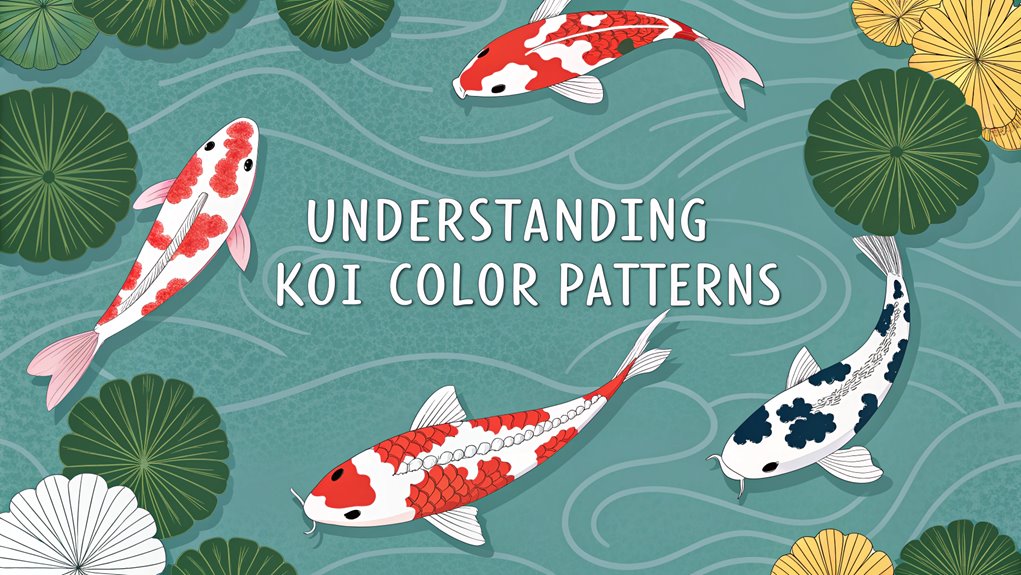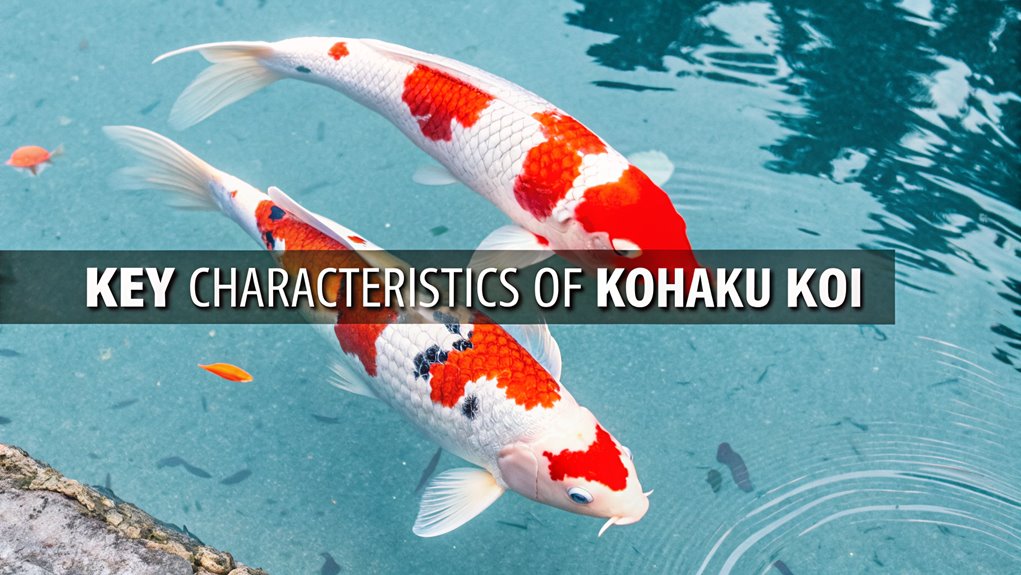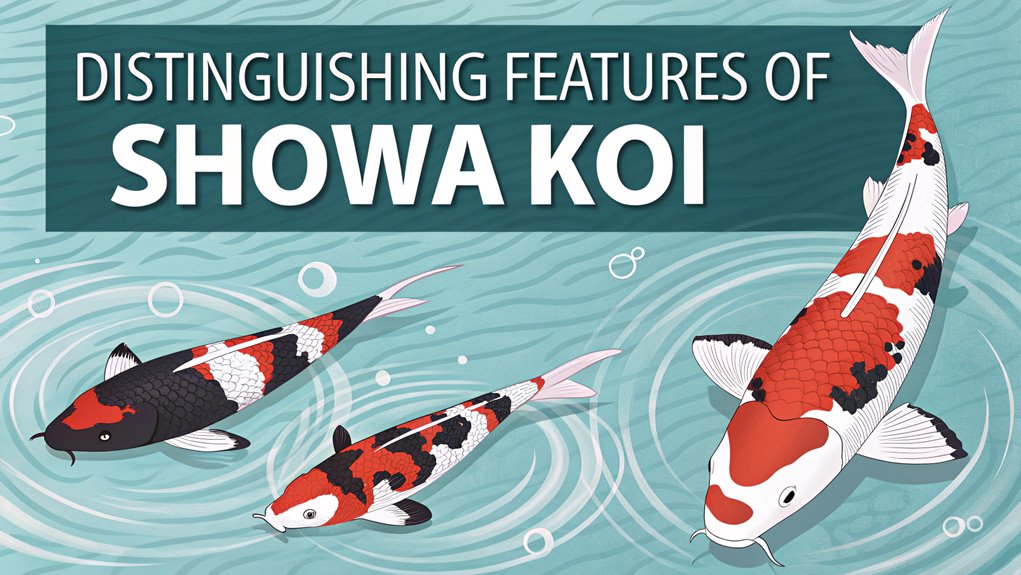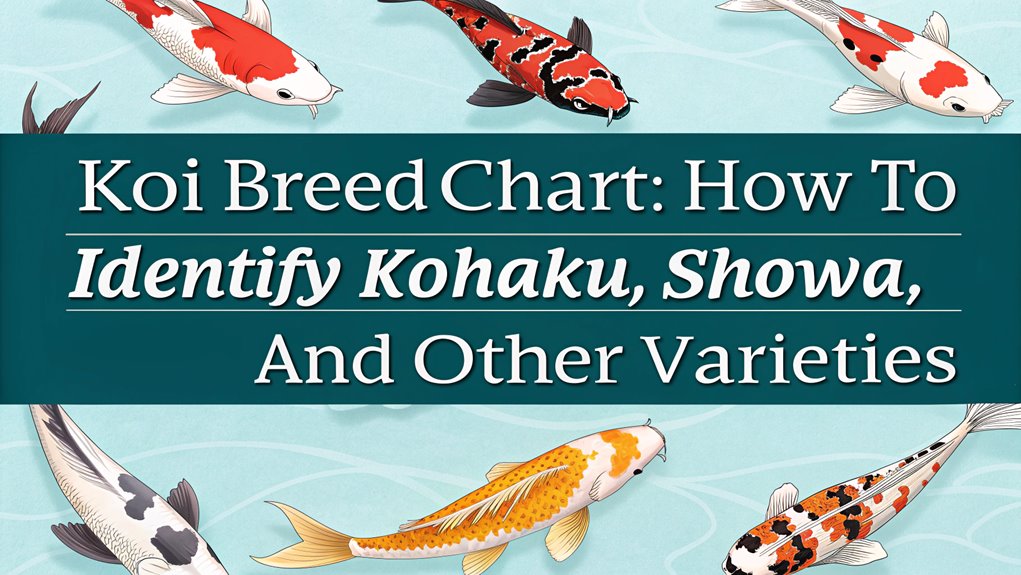To identify Kohaku, note its pure white body with sharp red markings. Distinguish Showa by its black base complemented with red and white patterns. Identify Sanke by its white canvas with red and black accents that don’t fully wrap around. Examine detailed variations like Gin Rin’s metallic sheen or Doitsu’s scaleless pattern. Recognize Utsurimono’s contrast patterns or Kawarimono’s unique hues. Continuing, you’ll master recognizing and appreciating these koi artistry nuances.
Key Facts Summarized
- Kohaku Koi feature a pure white body with vivid red patterns and crisp edges.
- Showa Koi have a dominant black base with balanced red and white patterns.
- Taisho Sanke Koi exhibit a white base with red and black patterns; black does not encircle the body.
- Utsurimono varieties display a black base with contrasting white or red patterns.
- Hikarimono Koi have metallic scales that reflect sunlight, adding a shimmering effect.
Understanding Koi Color Patterns

When diving into the world of Koi, understanding their color patterns is crucial for both appreciation and evaluation.
The Gosanke group, including Kohaku, Sanke, and Showa, showcases distinct Koi color patterns. Kohaku Koi, with their pure white (Shiroji) bodies and vivid red (Hi) designs, epitomize simplicity and elegance.
In contrast, Showa Koi display a striking black base with red and white patterns enveloping the body, creating dramatic visual impact.
Sanke Koi feature a white canvas adorned with red and black, where black accents rather than dominates. The clarity, balance, and symmetry of these patterns determine their quality in competitions.
Enhancing their allure, variations like Gin Rin add a shimmering metallic effect, elevating the appeal of these magnificent aquatic creatures. Additionally, understanding Koi color symbolism can deepen the appreciation of their beauty and significance in Japanese culture.
Key Characteristics of Kohaku Koi

Although Kohaku Koi may initially appear simple, their elegance lies in the precision of their color interplay.
You’ll notice the striking contrast of a pure white body (Shiroji) adorned with vivid red markings (Hi). High-quality specimens exhibit crisp edges, with red patterns that shouldn’t extend beyond the lateral line or eyes.
Within the Gosanke group, these Koi are paramount, often claiming top accolades in competitions. Diverse patterns like Nidan, Sandan, and even five-step offer a unique aesthetic.
Subtypes such as Doitsu Kohaku, known for their scaleless form, Tancho Kohaku with a singular red head spot, and Ginrin Kohaku featuring reflective scales, each present distinct visual allure.
Mastering their identification enriches your appreciation of Koi artistry, as understanding their selective breeding allows for deeper insight into the various color variations.
Distinguishing Features of Showa Koi

Showa Koi captivate enthusiasts with their striking tri-color pattern, where a dominant black base is intricately overlaid with vibrant red and white markings.
This variety is unique due to its black base color, which envelops the body, unlike the Sanke’s distinct lack of black on the head.
Quality Showa Koi exhibit a balanced distribution of colors—red, white, and black—with sharp, well-defined transitions enhancing their allure.
Each variation, such as Tancho Showa, Gin Rin Showa, and Doitsu Showa, brings distinct traits to the classic Showa aesthetic.
Key to distinguishing a high-grade Showa is the clarity and crispness at the edges where colors meet, ensuring the visual contrast remains pronounced and aesthetically pleasing.
Proper habitat maintenance is essential to ensure that Showa Koi thrive in their environment.
Identifying Traits of Taisho Sanke
Taisho Sanke, a cornerstone of koi appreciation, captivates with its solid white base adorned by striking red and black patterns.
Expert koi enthusiasts know that high-quality Taisho Sanke begins with an impeccable Kohaku pattern. The red and black patterns should be well-defined, creating a balanced aesthetic appeal.
Unlike Showa koi, the black patterns on Taisho Sanke don’t wrap around the entire body, a distinguishing feature that sets them apart.
Consider these key traits:
- Well-defined patterns: Red and black hues should complement the white base without overwhelming it.
- Varieties: Includes Doitsu Sanke, Maruten Sanke, and others, each maintaining core characteristics.
- Aesthetic balance: Patterns must enhance the koi’s natural beauty, ensuring visual harmony and grace.
Recognizing Other Unique Koi Varieties
Ever wondered what sets different koi varieties apart from each other? Each type boasts a unique charm.
Utsurimono varieties, like Shiro Utsuri and Hi Utsuri, captivate with their black base contrasted by white or red patterns.
Mujimono koi, such as Chagoi and Soragoi, offer understated elegance through solid colors without intricate patterns.
Hikarimono varieties, including Ogon and Platinum, dazzle with metallic scales that reflect sunlight, enhancing their visual splendor.
Kawarimono koi feature unusual patterns and colors, defying traditional classification.
Meanwhile, Doitsu koi stand out with their scaleless bodies, showcasing diverse patterns that vary widely, adding to their allure.
Choosing quality breeding stock is essential to ensure the continued beauty and health of these fascinating koi varieties.
Together, these varieties of koi contribute to the rich tapestry of koi beauty, each distinct from the classic Kohaku.
Frequently Asked Questions
How to Identify Kohaku Koi?
You identify Kohaku Koi by their pristine Shiroji (white body) contrasting with vivid Hi (red markings). Look for crisp Hi edges and symmetrical patterns like nidan or sandan. Ensure no red extends past the eyes or lateral line.
How to Identify Showa Koi?
Picture a koi with a deep black base, vivid red, and white patterns, especially with black on the head. You assess Showa Koi by examining color balance, defined pattern edges, and variations like Tancho or Gin Rin.
How Do I Identify What Koi I Have?
Examine your Koi’s pigmentation and pattern distribution. Identify base colors and markings: Kohaku features red on white; Showa has red, white, black; Sanke is similar to Showa but lacks black on the head. Use a guidebook.
What Are the Three Varieties of Koi?
Imagine you’re in a serene Japanese garden, observing Koi. The three varieties you’ll notice are Kohaku with red patterns, Sanke with additional black markings, and Showa distinguished by their black base. Each has unique color characteristics.
Conclusion
You’ve now got the tools to identify various koi breeds, much like a seasoned gardener who knows each plant by heart. By understanding the kohaku’s pure red and white simplicity, the showa’s dynamic interplay of black, white, and red, and the taisho sanke’s elegant design, you can appreciate their unique beauty. Recognizing other varieties will come naturally as you delve deeper into the world of koi, enhancing your expertise with each observation.

